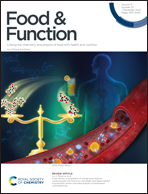Soy isoflavone ameliorated the alterations in circulating adipokines and microRNAs of mice fed a high-fat diet†
Abstract
Soy protein, containing isoflavones and bioactive peptides, is shown to have anti-obesity effects, but the main contributor and underlying mechanisms remain unclear. Recent studies have demonstrated that circulating microRNAs (miRNAs) act as important mediators in obesity and metabolic processes. In this study, we investigated whether soy protein components have distinctive effects on adiposity and circulating miRNA profiles in obese mice. C57BL/6J mice were divided into 4 groups, and each group was fed with a control, high-fat (HF), HF with low-isoflavone soy protein (HF/S), or HF with high-isoflavone soy protein (HF/SI) diet for 16 weeks. In the HF/SI group, changes in the serum adipokine levels, adipocyte diameter, and the number of crown-like structures (CLS) were alleviated compared to those of the HF group. In the HF/S group, the number of CLS was reduced. Decreases in body and adipose tissue weights were not observed in both HF/S and HF/SI groups. Through microarray analysis of serum miRNAs, we identified 23 differentially expressed miRNAs (DEMs) among the groups. The levels of most circulating DEMs were correlated with body weight, serum biochemical parameters, and adipose tissue histology. Functional analysis of predicted target genes of DEMs from both HF vs. CON and HF/S vs. CON comparisons revealed several cancer-related pathways. Only 2 DEMs were identified in the HF/SI vs. CON comparison. In conclusion, the present study confirmed that soy isoflavones are the main contributor to the health-beneficial effects of soy protein in diet-induced obesity. Notably, the extent of serum miRNA dysregulation coincided with obesity and altered the circulating adipokine levels. These findings provide additional insights into the role of soy protein in the regulation of circulating miRNAs in diet-induced obesity. Further work is required to validate the proposed functions of miRNAs in target tissues.

- This article is part of the themed collection: microRNA and its role in gene regulation: Celebrating the 2024 Physiology or Medicine Nobel Prize


 Please wait while we load your content...
Please wait while we load your content...